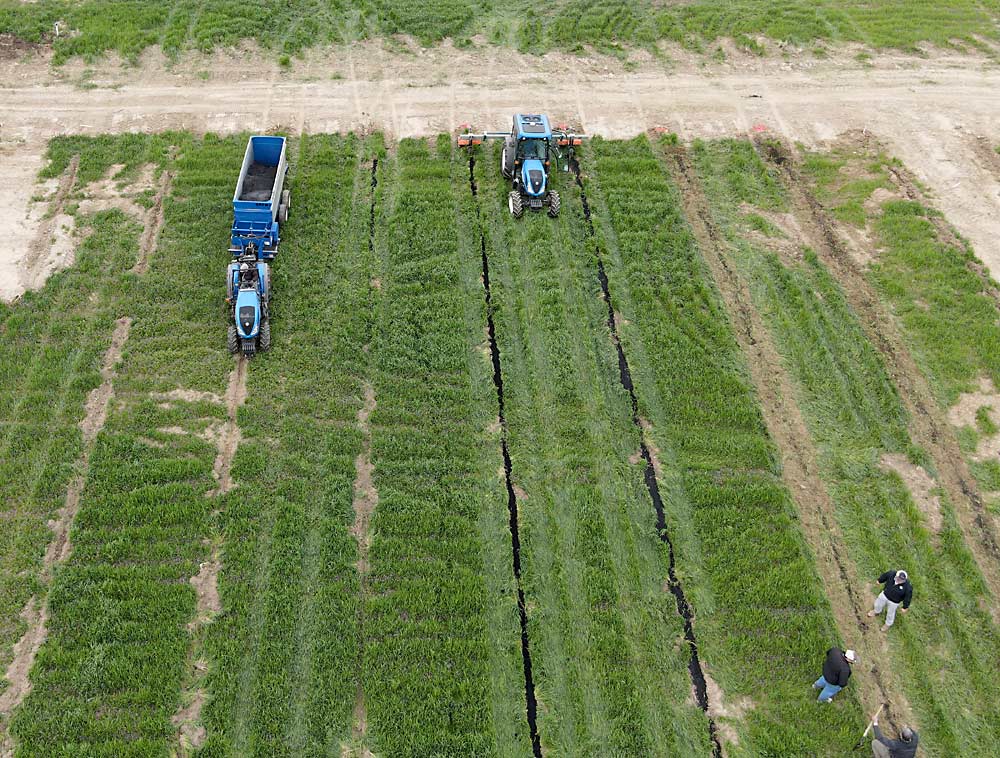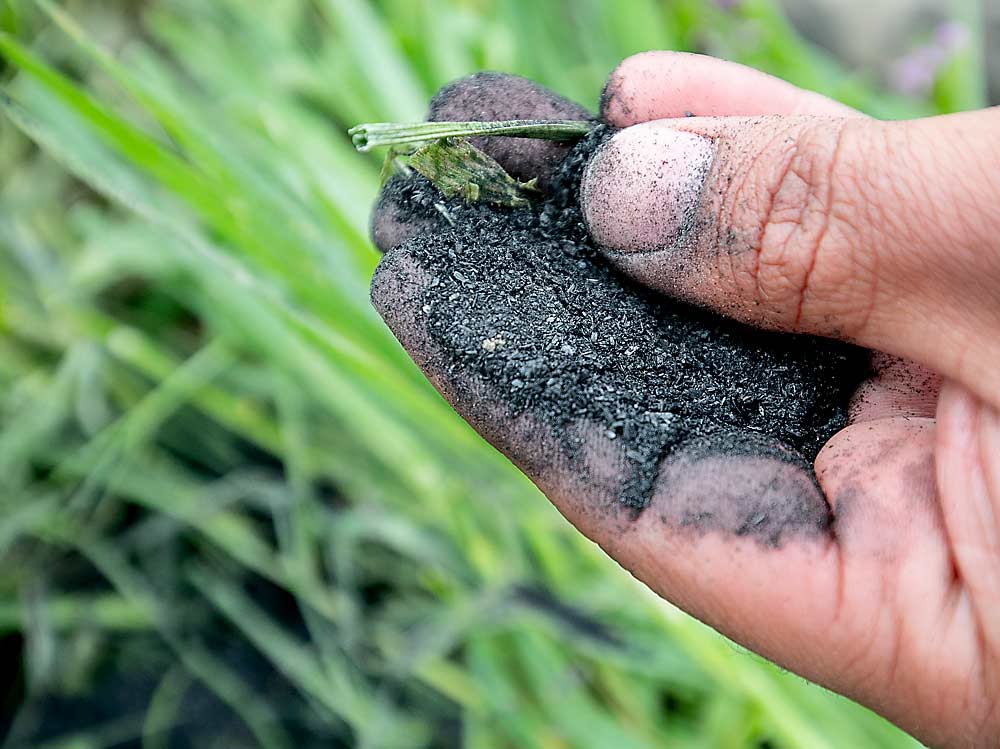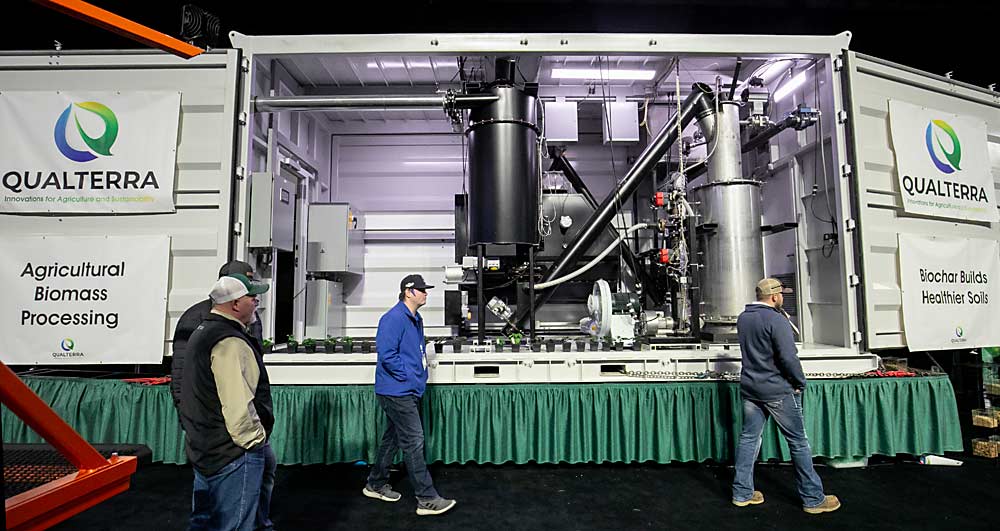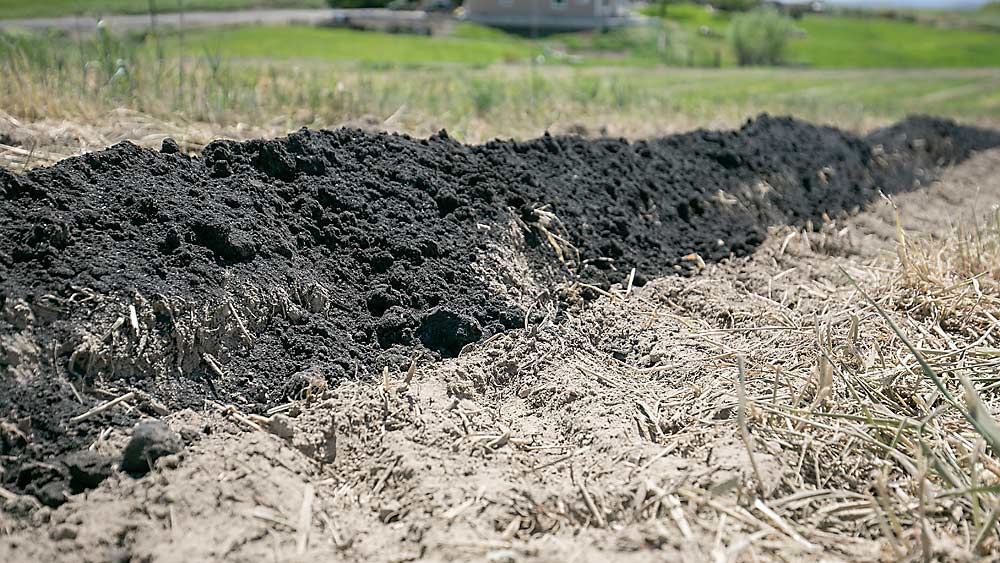
One byproduct of growing tree fruit: brush piles. Pruned branches and old trees, pulled to make way for new plantings.
Most of that brush burns. The carbon accumulated over years of fertilized growth goes up in smoke. Biochar production could interrupt that process, turning crop waste into a soil-carbon-boosting input and providing green energy at the same time.
“The idea is industrial symbiosis: How do we take a waste product and make a valuable product,” said David Drinkard, vice president for biomass processing and engineering at Qualterra, an ag tech company based in Pullman, Washington. “At its root, we’re cooking the biomass at a real high temperature in a low oxygen environment, leaving a carbon skeleton structure, which can stay in the ground for hundreds of years sequestering carbon.”

As a technology, biochar dates back thousands of years. Indigenous communities in the Amazon rainforest would burn brush and mix the charcoal into the soil to boost organic matter, nutrients and water-holding capacity. Modern approaches involved burning biomass in low-oxygen, high-heat conditions to produce biochar and syngas (short for synthesis gas, which can swap for natural gas in many applications) with no emissions.
Drinkard envisions Qualterra’s processing units — designed in a shipping container, for ease of transport — set up at farm operations with a lot of biomass waste to handle and a need for clean energy. Think hop driers running on hop waste or controlled-atmosphere rooms powered by prunings.
That future is a few years out, he admits. First, Qualterra must prove its theory that the biochar has significant benefits for the specific crops it’s targeting, including apples, cherries and hops, and prove that waste from those crop systems provides a high-quality input. He expects that orchard waste, like biomass from other fertilized crops, will yield biochar laden with more nutrients the new trees need than biochar made with timber waste.
Qualterra will haul old orchard wood to its biomass processing facilities in Spokane to test the theory this year, Drinkard said.

Research at Washington State University, led by horticulture professor Amit Dhingra, now of Texas A&M University, has shown that biochar made from different feedstocks resulted in different levels of benefit to tomato growth and production. It’s a lot faster to run trials on tomatoes, he told the tree fruit industry when he spoke about his biochar research at the Washington State Tree Fruit Association’s annual meeting in December.
He found the biochar made from wheat biomass had more of a beneficial effect than that made from timber biomass, which suggests that there is more to the biochar than just boosting soil carbon and water-holding capacity. Dhingra, a geneticist, also found changes in the soil microbiome and in the response of the tomato root systems.
“That’s exciting. But we have just started scratching the surface with these data,” he said. “We really want to see, when someone says a soil amendment works, what does that mean?”
Last year, NuPhy, a tissue culture propagation company in Pullman, Washington, that was based on technology Dhingra developed at WSU, acquired biomass company Ag Energy Solutions. That Spokane-based company was founded in 2010 by a wheat grower and engineer who had a vision of converting wheat straw to clean energy.
The company then renamed itself Qualterra late last year.
“Qualterra means quality earth, and that is what we are trying to live up to and provide good value back to our customers,” CEO Mike Werner said. Putting the tissue culture and molecular diagnostic testing parts of the company together with the biochar business made sense, since both technologies are targeting tree fruit industry customers, among others.
Dhingra serves as chief science officer for the company, which continues to be in a research phase as far as crop applications, Werner said.
Last year, grower Keith Veselka offered to host a biochar trial in an apple orchard his company, NWFM, operates. The idea reminded him of growers who have found that trees grow particularly well in the footprint of the old brush piles they had burned.
“We injected some biochar into the soil after planting and, over time, we noticed an increase in vigor,” he said. To test his visual observation, he worked with orchard imaging company Green Atlas to scan the entire block. That data showed more canopy density and leaf volume in the biochar-treated trees — significant enough to catch the attention of the imaging company, who asked what was going on in that part of the block.
That was enough to convince Veselka to scale up trials this year, mixing biochar into tree rows before planting both apple and cherry blocks. His team continues to experiment with different amounts and mixtures, but he said he believes the preplant application is the way to go.

“You get this one chance to boost your soils preplant and this is a permanent deal,” he said. “It’s not going to leach out and go away.”
Sequestering more carbon in the soil is an attractive idea, especially as more retail customers and orchard-owning institutional investors want to promote climate-smart agriculture.
“To me, it just makes sense,” he said. “There’s a lot of people worried about carbon output and carbon sequestration, and this is one way to do that. Hopefully the (practice) will scale.”
—by Kate Prengaman







Leave A Comment